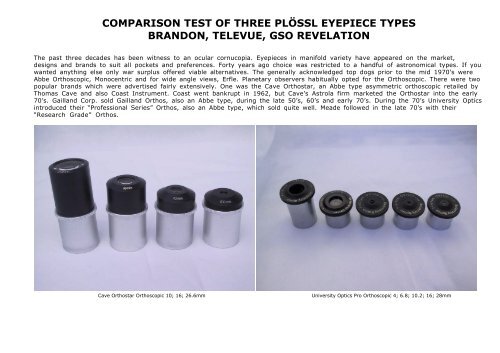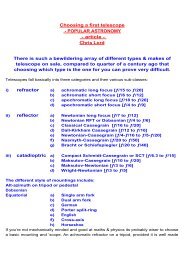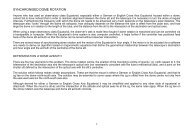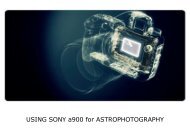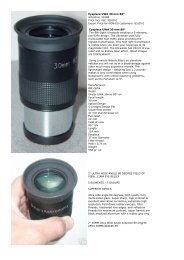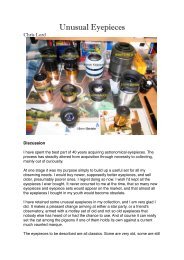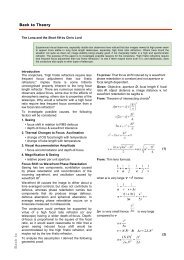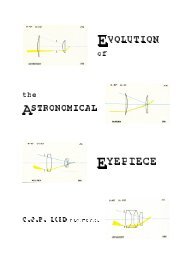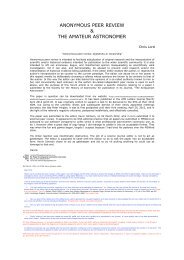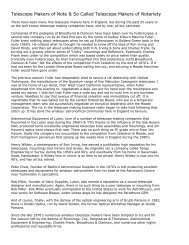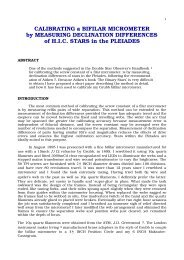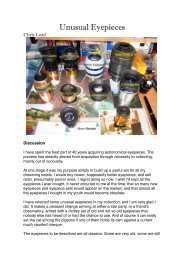comparison test of three plössl eyepiece types brandon, televue, gso ...
comparison test of three plössl eyepiece types brandon, televue, gso ...
comparison test of three plössl eyepiece types brandon, televue, gso ...
You also want an ePaper? Increase the reach of your titles
YUMPU automatically turns print PDFs into web optimized ePapers that Google loves.
COMPARISON TEST OF THREE PLÖSSL EYEPIECE TYPES<br />
BRANDON, TELEVUE, GSO REVELATION<br />
The past <strong>three</strong> decades has been witness to an ocular cornucopia. Eyepieces in manifold variety have appeared on the market,<br />
designs and brands to suit all pockets and preferences. Forty years ago choice was restricted to a handful <strong>of</strong> astronomical <strong>types</strong>. If you<br />
wanted anything else only war surplus <strong>of</strong>fered viable alternatives. The generally acknowledged top dogs prior to the mid 1970's were<br />
Abbe Orthoscopic, Monocentric and for wide angle views, Erfle. Planetary observers habitually opted for the Orthoscopic. There were two<br />
popular brands which were advertised fairly extensively. One was the Cave Orthostar, an Abbe type asymmetric orthoscopic retailed by<br />
Thomas Cave and also Coast Instrument. Coast went bankrupt in 1962, but Cave’s Astrola firm marketed the Orthostar into the early<br />
70’s. Gailland Corp. sold Gailland Orthos, also an Abbe type, during the late 50’s, 60’s and early 70’s. During the 70’s University Optics<br />
introduced their “Pr<strong>of</strong>essional Series” Orthos, also an Abbe type, which sold quite well. Meade followed in the late 70’s with their<br />
“Research Grade” Orthos.<br />
Cave Orthostar Orthoscopic 10; 16; 26.6mm University Optics Pro Orthoscopic 4; 6.8; 10.2; 16; 28mm
University Optics König 6.5 series II; 8; 12; 16; 24mm series I & Meade Research Grade Orthoscopic 7; 10.5mm<br />
note the physical similarity between the UO Pro Ortho & UO König series I & Cave Orthostar and Meade RG Ortho<br />
So where did the Plössl feature? Quite simply it didn't. The only readily procurable "Plössl" <strong>eyepiece</strong>s were war surplus Symmetrical<br />
<strong>eyepiece</strong>s removed from sighting or predictor 'scopes. Edmund Scientific in the 50’s & 60’s bought thousands <strong>of</strong> war surplus M-70 tank<br />
telescopes, and stripped out their 32mm Brandon <strong>eyepiece</strong> which they fitted into a 1 1/4-inch adaptor, and sold for $5.95 as a “Type<br />
III Kellner [Plössl]”.<br />
The Symmetrical <strong>eyepiece</strong> comprised a pair <strong>of</strong> achromatic doublets separated by approximately 20% their focal length. The<br />
arrangement produced a ghost image. Reflection between the doublets (even when antireflection coated as they were in many WWII<br />
<strong>types</strong>) emerged almost parallel to the eye beam. The object under observation was dogged by a pallid companion wherever you<br />
placed the image within the field <strong>of</strong> view.
During the mid 1970's something happened to change the reputation <strong>of</strong> the humble Plössl and raise it from its pariah status to a must<br />
have <strong>eyepiece</strong>. As far as I have been able to ascertain Eugene Cross was the first to deliberately market an astronomical <strong>eyepiece</strong><br />
purely on a brand name, the Clavé Plössl. Cross Optics created a brand image. A set <strong>of</strong> Clavé Plössls was what observers were<br />
supposed to aspire to. And like all branded goods they came with a price tag to match. The, "If you need to ask you can't afford", sort <strong>of</strong><br />
price tag.<br />
The origins <strong>of</strong> the Clavé Plössl reputation date back to a remark by Jean Texereau in his 1957 English edition <strong>of</strong> “How to Make a<br />
Telescope”. In 1965, a firm in New Jersey by the name <strong>of</strong> Special Optics began pushing the Clavé Plössl but the high prices did not<br />
attract many buyers.<br />
The design however did not originate with the Parisian firm Ets Clavé (Kinoptique), but Carl Zeiss Jena. It was designed by Albert König<br />
during the late 1930's and patented in Germany on January 28th 1938 Serial No. 251,464. König filed a US patent on January 18th<br />
1939 on behalf <strong>of</strong> CZJ and registered on October 8th 1940 as 2,217,281.<br />
König's patent describes two 4 element designs, a 3-1 Orthoscopic and an asymmetric 2-2 Plössl. It is the second design that is <strong>of</strong><br />
interest because König had reworked the symmetrical arrangement, placing the doublets almost in centre contact, and choosing<br />
surface radii and thicknesses so as to eliminate ghosts, formed either by the image or the counter reflection <strong>of</strong>f the cornea. The eye<br />
surface was flat, and the doublets were made from <strong>three</strong> different Schott glasses.<br />
During 1946 CZJ was divided, with the Jena division in East Germany under Soviet occupation, and a newly formed Carl Zeiss<br />
Oberkochen in the Allied occupied West. Ets Clavé acquired the König Plössl design and tooling and commenced manufacture under its<br />
own name.<br />
Eugene Cross subsequently transformed the reputation <strong>of</strong> Ets Clavé from a parochial inward looking French firm to a brand leader. But<br />
does the design merit the hyperbole?<br />
In September 1979, Leo Henzl jnr. the West Coast representative for Optical Techniques Inc. conducted a <strong>comparison</strong> <strong>test</strong> between his<br />
own branded König (2-1 Zeiss design by König derived from the 1940 patented design), Brandon Orthoscopic (a design by Chester<br />
Brandon in 1942 and a mirror image <strong>of</strong> König's 2-2 Plössl), and the Clavé Plössl.<br />
I found little to choose between either, but opted for the König because I considered the Clavé Plössl lent a warm hue to planetary<br />
images, whereas the König and the Brandon gave a colder hue, which I preferred.<br />
By the late 70’s true asymmetric Abbe type Orthoscopics were becoming expensive although arguably not quite so expensive as the<br />
Clavé Plössl. Nevertheless Eugene Cross' branding exercise displaced the Abbe Orthoscopic, so much so that almost any <strong>eyepiece</strong><br />
bearing the appellative "Plössl" promoted somewhere in the title, boosted sales. Hence for instance the 2-1-2 so called 'Super Plössl'<br />
(Erfle II). I possess <strong>three</strong> AstroPhysics Plössl (Symmetrical) from 1979; 30, 40 & 70mm purchased on the crest <strong>of</strong> Plössl frenzy.<br />
Cross eventually lost the exclusive franchise from Ets Clave, to S&S Optika and Roger Tuthill. Albert Nagler waded into the feeding<br />
frenzy with his TeleVue Plössl, a design registered in 1984, US Patent 4,482,217 November 13th. Nagler's design is nothing more than<br />
a Symmetrical, and in the 26mm focal length which forms the basis <strong>of</strong> his invention, the doublets have a 1mm spacing. Only two glass<br />
<strong>types</strong> and <strong>three</strong> different lens radii are used.
One sometimes, in the 50’s and 60’s, saw a Symmetrical designated Plössl, no one paid much attention. It was Nagler, who in<br />
adopting the Plössl designation for his Symmetrical and heavily advertising it as such, cashed in on the Clavé’s reputation.<br />
It is interesting contrasting the advertising claims <strong>of</strong> TeleVue and the actualité. The König asymmetric Plössl uses Schott SF10, SK5 &<br />
F2 glass, Albert Nagler's Symmetrical uses Schott SF5 & SSK5 or equivalent, neither being high index glasses, but standard crown and<br />
flint. It is König's choice <strong>of</strong> SF10 for the leading element <strong>of</strong> the field doublet, which is a high index glass, that defines its inherent<br />
quality, and bear in mind the König design (which is a true Plössl - being asymmetric) preceded Nagler's Symmetrical design by 46<br />
years!<br />
Chester Brandon's design followed König's design which may be used either way round! Brandon arrived at his design whilst working at<br />
the Frankford Arsenal. His choice <strong>of</strong> <strong>three</strong> high index glass <strong>types</strong> and four different lens radii is retained to this day. Chester Brandon<br />
advertised the Brandon Orthoscopic in Sky & Telescope throughout the 1950’s. He had the market on <strong>eyepiece</strong>s in the United States in<br />
that decade, except for war surplus. In focal lengths 4; 6; 8; 12; 16; 24; 32mm, Brandons were priced at $15.95. The Brandon<br />
reputation exceeded that <strong>of</strong> any other 1950’s <strong>eyepiece</strong>. Brandon moved his business from Malverne NY in the early 50’s to California,<br />
then around 1955-56 to Puerto Rico and renamed his firm “LIBRASCOPE”. In 1966 Don Yeier bought the remaining Brandon inventory<br />
and all rights and reintroduced the Brandon, which had not been available since 1962 following Brandon’s retirement in early 1963.<br />
How well does the Brandon and TeleVue Plössl <strong>eyepiece</strong> design perform on the bright planets? After being subjected to the unending<br />
TeleVue advertising hyperbole I set about attempting to resolve this question. Knowing what I do I could scarcely be an unbiased<br />
arbiter. I de<strong>test</strong> unsubstantiated advertising claims; I intensely dislike American advertising braggadocio, it smacks <strong>of</strong> the snake oil<br />
salesman. Observational <strong>test</strong>s were carried out by a member <strong>of</strong> my local astronomical society. I merely guided him in what to look for<br />
during the <strong>comparison</strong> <strong>test</strong>. Oh, and just to throw a spanner in the works, I introduced a set <strong>of</strong> Taiwanese GSO Revelation Plössl.<br />
Exactly! Just what can you expect for your hard earned money? Is the Brandon really worth the asking price <strong>of</strong> the only all US made<br />
<strong>eyepiece</strong>? Is the TV Plössl significantly better than the GSO? Would it prove a revelation?
Cost <strong>of</strong> acquisition:<br />
VERNONscope 1 1/4" Parfocal Brandon Oculars 32, 24, 16, 12, 8 boxed in hardwood case $1095<br />
TeleVue Optics 1 1/4" Parfocal Plössl Oculars 32, 25, 20, 15, 11, 8 (no case) £463<br />
GSO Revelation 1 1/4" Parfocal Plössl Oculars 32, 20, 15, 12, 9, 6 boxed with 5 filters in aluminum case £89<br />
Manufacturer's specifications (as presented on company’s website):<br />
BRANDON<br />
Four element designs give a flat, beautifully corrected 50° field <strong>of</strong> view.<br />
Optical elements are exactingly ground and hard-coated with magnesium fluoride.<br />
Precision metal parts are black-anodized for antireflection and machined to standard 1 1/4" diameter.<br />
Parfocal mechanical designs - no need to refocus when changing <strong>eyepiece</strong>s.<br />
Comfortable exit pupil distance for observing ease.<br />
Threaded at the base to accept all 1 1/4" VERNONscope Mounted Glass Filters.<br />
Rubber eyecups eliminate stray light, roll down for eyeglasses.
TELEVUE PLÖSSL GSO REVELATION PLÖSSL<br />
Focal Length Apparent Field Eye Relief Focal Length Apparent Field Eye Relief<br />
32 50º 22 32 52º 22<br />
25 50º 17 25 52º 22<br />
20 50º 14 20 52º 20<br />
15 50º 10 15 52º 13<br />
11 50º 8 12 52º 8<br />
8 50º 6 9 52º 6<br />
6 52º 5<br />
Reviewer’s comments:<br />
All <strong>three</strong> makes have black anodized aluminium barrels, and internally chased sleeves, and blackened lens edges.<br />
All selected focal lengths in each set are parfocalised.<br />
TV & GSO are multicoated on all air-glass surfaces whilst Brandon are bloomed.<br />
TV & GSO have hard chrome steel sleeves with undercuts and standard filter threads.<br />
Brandon use a filter thread peculiar to VERNONscope.<br />
All are fitted with fold down eyecups, and possess recessed eye lenses.<br />
All <strong>eyepiece</strong>s are supplied capped at both ends.
€<br />
CALIBRATION DATA: Nom Cal Field App Eye @f/6 Eye<br />
Fe' Fe(1) stop fov(2) lens (3) Relief(4)<br />
GSO Revelation Plössl 32 32.0 1.055 47º.3 0.980 0.90 20<br />
20 20.0 0.671 48º.2 0.665 0.52 11<br />
15 16.0 0.495 44º.2 0.487 0.35 7.6 no defined field edge<br />
12 12.0 0.420 50º.4 0.415 0.29 5.6<br />
9 9.4 0.305 46º.5 0.330 0.21 4.3<br />
6 6.0 0.226 54º.6 0.225 0.17 3.3 no defined field edge<br />
TeleVue Plössl II 20 20.6 0.672 46º.7 0.696 0.57 12.7<br />
15 14.9 0.490 47º.1 0.499 0.36 7.5<br />
11 10.6 0.350 47º.4 0.358 0.33 7.6<br />
8 7.7 0.254 47º.3 0.254 0.22 5<br />
VERNONscope Brandon Ortho 32 31.4 0.999 45º.5 1.140 0.87 20 eyecup 0.75 ID vignettes field<br />
24 24.0 0.851 51º.1 1.070 0.72 15 eyecup 0.75 ID<br />
16 15.4 0.465 43º.1 0.607 0.38 9<br />
12 12.0 0.347 41º.1 0.497 0.30 7.6<br />
8 8.0 0.234 41º.6 0.307 0.18 4.3<br />
notes<br />
(1) calibrated focal lengths (mm) obtained from exit pupil measurement using optical comparator and WO Megrez90<br />
(2) apparent field <strong>of</strong> view calculated from field stop diameter (inches) and calibrated focal length<br />
App fov<br />
ϑ = 6<br />
π sin−1 e<br />
2<br />
€<br />
e = E d<br />
F e<br />
€<br />
El = 2Er tan ϑ ⎛ ⎞<br />
⎜<br />
⎝ 2 ⎠<br />
where Ed is field stop dia.<br />
the measured apparent fov differs between that stated for the design, typically being less. It also varies between different focal lengths within each set. The GSO Plössl 15 & 6 had<br />
misplaced field stops.<br />
(3) minimum eye lens diameter (inches) @ f/6<br />
minimum eye lens dia.<br />
€<br />
⎟ + E p where<br />
€<br />
E r is eye relief<br />
€<br />
E p is exit pupil @ f/6<br />
€<br />
∴E p = F e<br />
6<br />
The Brandon 32 & 20 <strong>eyepiece</strong> rely on a 3/4-inch aperture in the eyecup to define the useable eye lens diameter.<br />
(4) measured eye relief (mm). The eye relief values presented by TeleVue and GSO tend to be optimisitic, and are presumably based on the optical design rather than the physical<br />
configuration. Eye relief was measured from the surface <strong>of</strong> the <strong>eyepiece</strong> to the cornea, not the surface <strong>of</strong> the eye lens itself.
OBSERVATIONAL<br />
TESTS<br />
NOMINAL<br />
FOCAL LENGTH<br />
Field stop definition<br />
Field stop fringing<br />
Field illumination<br />
Field accessibility<br />
Internal reflections<br />
Field scatter<br />
Field Curvature<br />
Lateral Colour<br />
Astigmatism & coma<br />
Distortion<br />
Contrast & Transmission (7)<br />
Ghosting<br />
32<br />
sharp<br />
none<br />
even<br />
100%<br />
yes (1)<br />
none<br />
slight(3)<br />
none<br />
sag(5)<br />
neg(6)<br />
ex ex ex ex vg vg vg vg ex ex ex ex ex vg ex<br />
none<br />
GSO Revelation Plössl<br />
20<br />
sharp<br />
pale<br />
green<br />
even<br />
100%<br />
none<br />
none<br />
slight(3)<br />
o/corr(4)<br />
sag(5)<br />
neg(6)<br />
none<br />
unsharp<br />
pale<br />
blue<br />
uneven<br />
yes (2)<br />
none<br />
slight(3)<br />
o/corr(4)<br />
sag(5)<br />
neg(6)<br />
none<br />
sharp<br />
none<br />
even<br />
100%<br />
slight (2)<br />
none<br />
slight(3)<br />
slight(4)<br />
sag(5)<br />
neg(6)<br />
none<br />
sharp<br />
pale<br />
blue<br />
even<br />
100%<br />
slight (2)<br />
none<br />
slight(3)<br />
o/corr(4)<br />
sag(5)<br />
neg(6)<br />
none<br />
unsharp<br />
none<br />
uneven<br />
80-%<br />
none<br />
slight<br />
slight(3)<br />
o/corr(4)<br />
sag(5)<br />
neg(6)<br />
none<br />
sharp<br />
lemon<br />
yellow<br />
even<br />
100%<br />
none<br />
none<br />
slight(3)<br />
o/corr(4)<br />
sag(5)<br />
neg(6)<br />
none<br />
notes:<br />
(1) <strong>of</strong>f field stop<br />
(2) <strong>of</strong>f field lens lock ring<br />
(3) modest positive Petzval Sum (field convex to eye)<br />
(4) overcorrected - red outwards from 70% field radius; undercorrected - blue outwards at field boundary<br />
(5) negative astigmatism - sagittal dominates - image becomes arcuate at field boundary<br />
(6) slight negative (barrel) distortion, exceeds Abbe Ortho @ f/5<br />
(7) ex = excellent vg = very good<br />
15<br />
80%<br />
12<br />
9<br />
6<br />
20<br />
TeleVue Plössl II<br />
15<br />
sharp<br />
yellow<br />
green<br />
even<br />
100%<br />
none<br />
none<br />
slight(3)<br />
o/corr(4)<br />
sag(5)<br />
neg(6)<br />
none<br />
11<br />
sharp<br />
lemon<br />
yellow<br />
even<br />
100%<br />
none<br />
none<br />
slight(3)<br />
o/corr(4)<br />
sag(5)<br />
neg(6)<br />
none<br />
8<br />
sharp<br />
yellow<br />
green<br />
even<br />
100%<br />
none<br />
none<br />
slight(3)<br />
o/corr(4)<br />
sag(5)<br />
neg(6)<br />
none<br />
32<br />
sharp<br />
none<br />
even<br />
100%<br />
none<br />
none<br />
slight(3)<br />
none<br />
sag(5)<br />
neg(6)<br />
none<br />
VERNONscope Brandon<br />
Orthoscopic<br />
24<br />
sharp<br />
yellow<br />
green<br />
even<br />
100%<br />
none<br />
none<br />
slight(3)<br />
o/corr(4)<br />
sag(5)<br />
neg(6)<br />
none<br />
16<br />
sharp<br />
blue<br />
even<br />
100%<br />
none<br />
none<br />
slight(3)<br />
o/corr(4)<br />
sag(5)<br />
neg(6)<br />
none<br />
12<br />
sharp<br />
none<br />
even<br />
100%<br />
none<br />
none<br />
slight(3)<br />
none<br />
sag(5)<br />
neg(6)<br />
none<br />
8<br />
sharp<br />
yellow<br />
green<br />
even<br />
100%<br />
none<br />
none<br />
slight(3)<br />
o/corr(4)<br />
sag(5)<br />
neg(6)<br />
none
FIELD TESTS:<br />
I organized a Star Party at New Moon weekend commencing September 26th 2008 at Lane Ends bird sanctuary near Pilling, Over Wyre,<br />
on the coast <strong>of</strong> Morecambe Bay, Lancashire, England. The night was clear, with a little cirrus, and a slight mist. Sky darkness I<br />
estimated to be 20.6 mag / square arcsec, ZLM 5.8 and Seeing: Antoniadi II.<br />
Tests were made on a Megrez 90 semi-apo (f/6.9) and a 254mm f/4.7 Newtonian. The optical quality <strong>of</strong> both telescopes was well<br />
above the Rayleigh criterion.<br />
The <strong>comparison</strong>s were made by an observer relatively new to the hobby, who had acquired the necessary observing skills, yet<br />
someone unfamiliar with these specific <strong>eyepiece</strong>s. The observations were made blind, that is, I did not tell the observer which <strong>eyepiece</strong><br />
make he was using. I arranged the <strong>three</strong> sets into focal length groups, and handed each group in random order and left the observer<br />
to rank them according to image clarity, contrast, and field performance (fidelity across the fov). At no time was the observer prompted<br />
as to which make he was using, or its supposed hierarchical ranking.<br />
Observation <strong>test</strong>s were conducted on Jupiter (Seeing II-III) and its Galilean satellites and a pair <strong>of</strong> field stars. The planet was<br />
examined centred, and allowed to drift across the fov.<br />
ranking with 10-inch f/4.7 Newtonian in order <strong>of</strong> performance<br />
best on left, worst on right:<br />
(judged on the final seven criteria in observational <strong>test</strong>s table)<br />
rank A<br />
8mm TV Plössl<br />
12mm GSO Plössl<br />
15mm GSO Plössl<br />
rank B rank C<br />
9mm GSO Plössl<br />
11mm TV Plössl<br />
16mm Brandon<br />
8mm Brandon<br />
12mm Brandon<br />
15mm TV Plössl<br />
ranking with 90mm f/6.9 Semi-apo in order <strong>of</strong> performance<br />
best on left, worst on right:<br />
(judged on the final seven criteria in observational <strong>test</strong>s table)<br />
rank A<br />
8mm Brandon<br />
12mm Brandon<br />
16mm Brandon<br />
rank B<br />
9mm GSO Plössl<br />
11mm TV Plössl<br />
15mm GSO Plössl<br />
the Brandon performed markedly better at f/6.9 than f/4.7<br />
observational <strong>test</strong>s were confined to Jupiter<br />
rank C<br />
8mm TV Plössl<br />
12mm GSO Plössl<br />
15mm TV Plössl
FINDINGS & DISCUSSION:<br />
At the design focal ratio (f/7) the Brandon Orthoscopic was the better <strong>eyepiece</strong> at medium powers, matched to the seeing, followed by<br />
the GSO Plössl which in turn had the edge on the TV Plössl. At the faster focal ratio f/4.7 the performance <strong>of</strong> the Brandon was<br />
noticeably less good, with the GSO Plössl taking the lead. The performance <strong>of</strong> all the <strong>eyepiece</strong>s deteriorated at f/4.7 compared to<br />
f/6.9.<br />
The lower definition and edge quality <strong>of</strong> the Brandon at f/4.7 did not come as much <strong>of</strong> a surprise. What did intrigue was the quality <strong>of</strong><br />
the GSO Plössl compared to the TV Plössl. Mechanically there is not much to choose between either brand. The TeleVue is marginally<br />
better made, with tighter tolerances in locating the field stop. This however is not reflected in its optical performance.<br />
The Brandon came into its own at f/6.9 which is very close to the design f/7 limit. Definition was noticeably superior in the Brandon<br />
than the TV Plössl or the GSO Plössl, and the GSO Plössl had the edge on the TV Plössl at f/6.9.<br />
My <strong>test</strong>s exemplifies the law <strong>of</strong> diminishing returns, for whilst the Vernonscope Brandon Orthoscopic perform noticeably better at f/6.9<br />
than the TV Plössl, the difference in cost is not in proportion to the difference in image quality; one cannot say the Brandon<br />
Orthoscopic works <strong>three</strong> times better than the TV Plössl.<br />
However by far the best value is the GSO Plössl. It consistently outperformed or rivalled the TV Plössl at roughly half the price, even<br />
less if bought cased via Amazon. Not only does the GSO Plössl represent the best value, it ranks overall a better planetary <strong>eyepiece</strong><br />
than the TV Plössl, exceeded only by the Brandon which costs almost ten times more.
CONCLUSION:<br />
In the introduction I explained the reasons why the Plössl <strong>eyepiece</strong> deservedly had an indifferent if not downright poor reputation<br />
amongst Lunar & planetary observers during the immediate post war period. I also explained the difference between a true<br />
asymmetric Plössl and a Symmetrical. From the post war period through the early 1970’s the Abbe Orthoscopic and Brandon<br />
Orthoscopic had a well deserved reputation amongst Lunar & planetary observers. I have explained the reasons why their reputation<br />
became eclipsed by the Plössl, be it a true Plössl (which very few are) or the Symmetrical design masquerading as a true Plössl.<br />
When conducting side by side trials <strong>of</strong> the Clavé Plössl with Leo Henzl jnr. in September 1979, I concluded the König I rivalled the<br />
Brandon and the Clavé. However the <strong>comparison</strong> was made using an OTI Quantum 6 at f/15. This to my mind begs the question, how<br />
well does the König I compare to the Zeiss Abbe Orthoscopic on a modern f/7 apo? In the appendix I have included <strong>three</strong> <strong>eyepiece</strong><br />
design descriptions taken from the forthcoming Zeiss Optical Handbook. Compare the Zeiss Abbe Orthoscopic to the Zeiss König I.<br />
What little difference there is would be too subtle to be detected visually. Note also the slightly inferior performance <strong>of</strong> the Plössl, when<br />
designed as a Symmetrical, like the TeleVue Plössl.<br />
Based on my previous experience and these recent trials I can only conclude that the Abbe asymmetric style Orthoscopic favoured by<br />
the earlier generation <strong>of</strong> Lunar & planetary observers, i.e. Cave Orthostar and UO Pro Orthoscopic, would outperform the much vaunted<br />
and over-hyped TV Plössl. Furthermore the completely disregarded Zeiss König I <strong>eyepiece</strong>, sold by University Optics in the late 1970’s,<br />
would easily out perform the TV Plössl and give the Zeiss Abbe a good run for its money, there being so marginal a difference in their<br />
optical properties.<br />
I have also provided a historical perspective to the designs <strong>of</strong> the König, Brandon and TV Plössl, and reasons why, despite TeleVue’s<br />
advertising claims, the TV Plössl is only a Symmetrical, and consequently incapable <strong>of</strong> a noticeably superior performance. I have been<br />
made aware <strong>of</strong> the reputation <strong>of</strong> Plössl <strong>eyepiece</strong>s in general and the TV Plössl in particular. My findings leave no doubt that the<br />
reputation is unwarranted. When it comes to the detection <strong>of</strong> low contrast detail and preservation <strong>of</strong> low contrast details in planetary<br />
images (Jupiter in this instance - a difficult object owing to its low surface contrast) there is nothing about the TV Plössl design to<br />
commend its preferred status to either the Zeiss Abbe Orthoscopic or Zeiss König I, or the Brandon Orthoscopic.<br />
Chris Lord
APPENDIX: Optical design and trigonometric ray trace <strong>of</strong> the <strong>eyepiece</strong> designs reviewed<br />
© Handbook <strong>of</strong> Optical Systems Herbert Gross Wiley-VCH Berlin 2009:<br />
Abbe Orthoscopic:
Konig orthoscopic:
Plossl orthoscopic:


